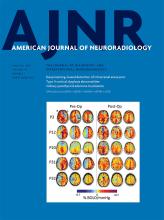Index by author
Derraz, I.
- FELLOWS' JOURNAL CLUBAdult BrainYou have accessTwo-Layered Susceptibility Vessel Sign and High Overestimation Ratio on MRI Are Predictive of Cardioembolic StrokeR. Bourcier, I. Derraz, S. Bracard, C. Oppenheim and O. Naggara on behalf of the THRACE InvestigatorsAmerican Journal of Neuroradiology January 2019, 40 (1) 65-67; DOI: https://doi.org/10.3174/ajnr.A5865
Two characteristics of the susceptibility vessel sign, overestimation ratio (overR), a quantitative evaluation of the susceptibility vessel sign, and the 2-layered susceptibility vessel sign (TL-SVS), were reported to predict cardioembolic stroke. These 2 biomarkers, on 1.5T or 3T systems (159 and 101 patients, respectively), demonstrated high specificity (0.77 at 1.5T and 1 at 3T) and their simultaneous presence is highly associated with cardioembolism.
Desal, H.
- FELLOWS' JOURNAL CLUBAdult BrainYou have accessMRI Quantitative T2* Mapping to Predict Dominant Composition of In Vitro ThrombusR. Bourcier, R. Pautre, M. Mirza, C. Castets, J. Darcourt, J. Labreuche, L. Detraz, H. Desal, J.-M. Serfaty and C. ToquetAmerican Journal of Neuroradiology January 2019, 40 (1) 59-64; DOI: https://doi.org/10.3174/ajnr.A5938
Thirty-five thrombus analogs of different compositions were scanned with an MR imaging quantitative T2* mapping sequence. Two radiologists, blinded to thrombus composition, measured the thrombus-T2* relaxation time twice, at an interval of 2 weeks. Quantitative histologic evaluations of red blood cell content were performed. Inter- and intraobserver reproducibility of the thrombus-T2* relaxation time was assessed by calculating intraclass correlation coefficients. MR imaging quantitative T2* mapping can reliably identify the thrombus red blood cell content in vitro. This fast, easy-to-use sequence could be implemented in routine practice.
Detraz, L.
- FELLOWS' JOURNAL CLUBAdult BrainYou have accessMRI Quantitative T2* Mapping to Predict Dominant Composition of In Vitro ThrombusR. Bourcier, R. Pautre, M. Mirza, C. Castets, J. Darcourt, J. Labreuche, L. Detraz, H. Desal, J.-M. Serfaty and C. ToquetAmerican Journal of Neuroradiology January 2019, 40 (1) 59-64; DOI: https://doi.org/10.3174/ajnr.A5938
Thirty-five thrombus analogs of different compositions were scanned with an MR imaging quantitative T2* mapping sequence. Two radiologists, blinded to thrombus composition, measured the thrombus-T2* relaxation time twice, at an interval of 2 weeks. Quantitative histologic evaluations of red blood cell content were performed. Inter- and intraobserver reproducibility of the thrombus-T2* relaxation time was assessed by calculating intraclass correlation coefficients. MR imaging quantitative T2* mapping can reliably identify the thrombus red blood cell content in vitro. This fast, easy-to-use sequence could be implemented in routine practice.
De Weerdt, E.
- Adult BrainYou have accessCompressed Sensing–Sensitivity Encoding (CS-SENSE) Accelerated Brain Imaging: Reduced Scan Time without Reduced Image QualityJ.E. Vranic, N.M. Cross, Y. Wang, D.S. Hippe, E. de Weerdt and M. Mossa-BashaAmerican Journal of Neuroradiology January 2019, 40 (1) 92-98; DOI: https://doi.org/10.3174/ajnr.A5905
Duffin, J.
- EDITOR'S CHOICEAdult BrainYou have accessImproved White Matter Cerebrovascular Reactivity after Revascularization in Patients with Steno-Occlusive DiseaseL. McKetton, L. Venkatraghavan, C. Rosen, D.M. Mandell, K. Sam, O. Sobczyk, J. Poublanc, E. Gray, A. Crawley, J. Duffin, J.A. Fisher and D.J. MikulisAmerican Journal of Neuroradiology January 2019, 40 (1) 45-50; DOI: https://doi.org/10.3174/ajnr.A5912
Thirty-five patients with steno-occlusive disease (Moyamoya disease [n = 24], Moyamoya syndrome [n = 3], atherosclerosis [n = 6], vasculitis [n = 1], and idiopathic stenosis [n = 1]) who underwent unilateral brain revascularization using a direct superficial temporal artery–to-MCA bypass were evaluated. WM cerebrovascular reactivity was measured preoperatively and postoperatively using BOLD MR imaging during iso-oxic hypercapnic changes in end-tidal carbon dioxide. WM cerebrovascular reactivity significantly improved after direct unilateral superficial temporal artery–to-MCA bypass in the revascularized hemisphere in the MCA territory and in the anterior cerebral artery territory.
Dymarkowski, S.
- Pediatric NeuroimagingYou have accessReliability of MR Imaging–Based Posterior Fossa and Brain Stem Measurements in Open Spinal Dysraphism in the Era of Fetal SurgeryM. Aertsen, J. Verduyckt, F. De Keyzer, T. Vercauteren, F. Van Calenbergh, L. De Catte, S. Dymarkowski, P. Demaerel and J. DeprestAmerican Journal of Neuroradiology January 2019, 40 (1) 191-198; DOI: https://doi.org/10.3174/ajnr.A5930
El-deiry, M.W.
- Head and Neck ImagingOpen AccessImaging of Surgical Free Flaps in Head and Neck ReconstructionJ.L. McCarty, A.S. Corey, M.W. El-Deiry, H.M. Baddour, B.M. Cavazuti and P.A. HudginsAmerican Journal of Neuroradiology January 2019, 40 (1) 5-13; DOI: https://doi.org/10.3174/ajnr.A5776
Elefante, A.
- EDITOR'S CHOICEAdult BrainOpen AccessDeterminants of Deep Gray Matter Atrophy in Multiple Sclerosis: A Multimodal MRI StudyG. Pontillo, S. Cocozza, R. Lanzillo, C. Russo, M.D. Stasi, C. Paolella, E.A. Vola, C. Criscuolo, P. Borrelli, G. Palma, E. Tedeschi, V.B. Morra, A. Elefante and A. BrunettiAmerican Journal of Neuroradiology January 2019, 40 (1) 99-106; DOI: https://doi.org/10.3174/ajnr.A5915
Seventy-seven patients with MS and 44 healthy controls were enrolled in this cross-sectional study. MR imaging investigation included volumetric, diffusion tensor imaging, perfusion weighted imaging, and Quantitative Susceptibility Mapping analyses. Deep gray matter structures were automatically segmented to obtain volumes and mean values for each MR imaging metric in the thalamus, caudate, putamen, and globus pallidus. Patients with MS showed a multifaceted involvement of the thalamus and basal ganglia, with significant atrophy of all deep gray matter structures. In the relapsing-remitting MS group, WM lesion burden proved to be the main contributor to volume loss for all deep gray matter structures.
Elstrott, S.
- Adult BrainYou have accessDefining the Normal Dorsal Contour of the Corpus Callosum with TimeK.L. Krause, D. Howard, D.R. Pettersson, S. Elstrott, D. Ross, J.T. Obayashi, R. Barajas, A. Bonde and J.M. PollockAmerican Journal of Neuroradiology January 2019, 40 (1) 86-91; DOI: https://doi.org/10.3174/ajnr.A5886
Emamzadehfard, S.
- LetterYou have accessDisproportionate International Contributions to Subspecialties of Neuroradiology in the American Journal of NeuroradiologyS. Emamzadehfard, V. Eslami, D.M. Yousem and S. SahraianAmerican Journal of Neuroradiology January 2019, 40 (1) E3-E4; DOI: https://doi.org/10.3174/ajnr.A5885








